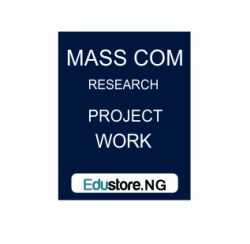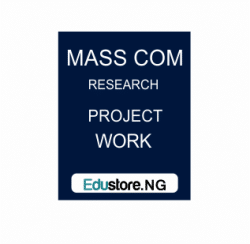CHAPTER ONE
1.0 Introduction
1.1 Background of the Study
A century and half ago, communication between countries involved physical presence. Once, a reporter had to run as fast as possible back to the newsroom after interviewing and tried to beat the competition to print. With the advent of the digital age the role of the journalist changed.
The inception of information communication technology such as the internet has made it possible to find out about events without actually being there. Journalists can report news across the world over the internet.
Throughout history, developments in technology and communication have gone hand-in-hand, and the latest technological developments such as the internet have resulted in the advancement of the science of communication to a new level. The process of human communication has evolved over the years, with many path-breaking inventions and discoveries heralding revolutions. The invention of pictographs or the first written communication in the ancient world brought about written communication. These writings were on stone, and remained immovable.
The invention of paper, papyrus and wax, culminating in the invention of the printing press in the 15th century made possible transfer of documents from one place to another, allowing for uniformity of languages over long distances. Lawal, A.T. (2005). The latest revolution is the widespread application of electronic technology such as electronic waves and signals to communicate, manifesting in the electronic creation and transfer of documents over the World Wide Web (www.wikipediacom)
Social media which are form of electronic communication have become the highest activity on the internet. They refer to social networking websites developed to specifically to help people share their views and stay in touch with their friends, relatives and well- wishers.
fake profiles and began losing members. Some of those members went to MySpace, which had actually started in 1999 but became better known in 2003.Its roots are a little muddy because it received financial and logistical support from another company called e-Universe, and most of the early users were e-Universe employees but Tom Anderson and Chris DeWolfe are given credit for much of the innovations and success of the site which built up to 115 million users worldwide. Members post bios, photos, blogs, videos, and other things that strike their fancy, and some TV programmes to air on MySpace. In 2005, Rupert Murdoch‟s News Corporation (parent of Fox Broadcasting) bought MySpace for 580 million dollars.
Similarly, Twitter is an online social networking service and microblogging service that enables its users to send and read text-based messages of up to 140 characters, known as “tweets”. Olayinka, S. O. (2014)
1.2 Statement of the Problem
Social media have certainly changed the way journalists work, how stories are developed and disseminated. Social media or online journalism places far more power in the hands of the users allowing the reader to challenge the traditional role of information dissemination. Traditional media have been forced to adopt the new media from wider reach and accessibility.
To this end, the research is geared towards comparing social media and radio stations on the assessment of news information using Twitter and Splash F.M Ibadan.
1.2 Objectives of the Study
The study had the following objectives:
- To ascertain whether University of Ibadan students’ prefer Twitter to Splash FM .
- To examine factors influence students’ preference for Twitter over Splash fm and why if
- To ascertain some of the problems confronting social networking sites as source of information particularly twitter.
- Research Questions
- To what extent do University Ibadan students’ prefer Twitter to Splash FM?
- What factors influence students’ preference for Twitter and why if yes?
What are the problems of social networking sites as source of information?
1.5 Scope of the Study
The scope of this study has been narrowed down to focus on University of Ibadan students. The demographic factors of the students will be examines such as academic levels, age, course of study, gender, marital status and other before the structuring and administration of research instrument (questionnaire). With the view possibly ascertain the degree of communication effectiveness due to technology change.
1.6 Significance of the Study
This study will be of immeasurable importance to journalists, media organizations, news agencies, editors, lecturers and students in the field of journalism and mass communication as well as other researchers who will want to embark on same study the future.
The study will help journalists to source useful information by using social media networking tools as well as provide them with a guide on how to write online stories. It will also help journalists to interact with their audience and identify their information needs. The study will also help journalists who have rarely embraced social media to do so in order to increase their productivity.
1.7 Limitation to the Study
- Duration for the research work is relatively short.
- Stress emanated from other academic activities is also another constrain.
- Little materials are also available because the work is relatively new.
1.8 Definition of Terms
Information Technology: It refers to the application of computers and telecommunications equipment to store, retrieve, transmit and manipulate data, it also encompasses other information distribution technologies such as television and telephones, computer hardware, software, electronics, semiconductors, internet, telecom equipment, e-commerce and computer services.
Social Networking: A group of internet-based applications that build on the ideological and technological foundations of web 2.0 and that allow the creation and exchange of user-generated content. (Kaplan and Haenlein, 2010)
Blogs: A blog (a contraction of the term “web log”) is a type of website, usually maintained by an individual with regular entries of commentary, descriptions of events, or other material such as graphics or video. Entries are commonly displayed in reverse-chronological order.
Information: This means an idea, feeling, expression packaged in a particular form.
Internet: It refers to global computer network providing a variety of information and communication facilities, consisting of interconnected networks using standardized communication protocols.
Citizen Journalism: This is the practice is a term which describes the act of individual within a given society, community, state or nation engaging in the gathering, processing and publishing of news materials.
Social media: The term refers to the Internet-based social networking websites developed to specifically help people share their views and stay in touch with their friends, relatives and well wishers such as Twitter, Facebook, Instagram, Whatsapp, Wikipedia, YouTube, and other social media networking tools.
Journalism: This is the practice of writing, editing, and disseminating information to the public through radio, television, newspaper and magazine.
Modern journalism: It is a term used to describe the new era in journalism where internet and computers are used in almost every journalistic activity.
Related: social media in news, radio stations, news information, facebook, new media, twitter and splash Fm, online news, streaming, webcasting, podcasting, news on social media.
DOWNLOAD COMPLETE WORK- For Reference Only: Materials are for research, citation, and idea generation purposes and not for submission as your original final year project work.
- Avoid Plagiarism: Do not copy or submit this content as your own project. Doing so may result in academic consequences.
- Use as a Framework: This complete project research material should guide the development of your own final year project work.
- Academic Access: This platform is designed to reduce the stress of visiting school libraries by providing easy access to research materials.
- Institutional Support: Tertiary institutions encourage the review of previous academic works such as journals and theses.
- Open Education: The site is maintained through paid subscriptions to continue offering open access educational resources.




